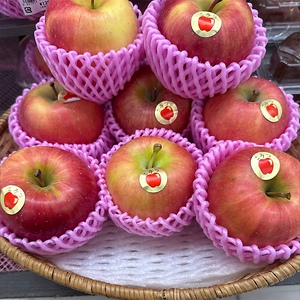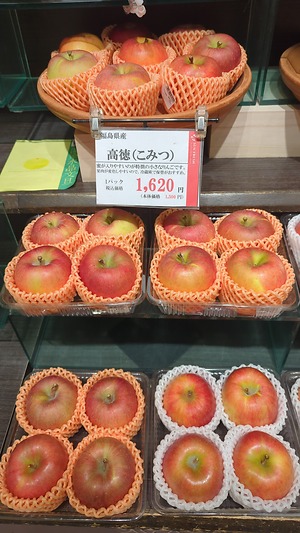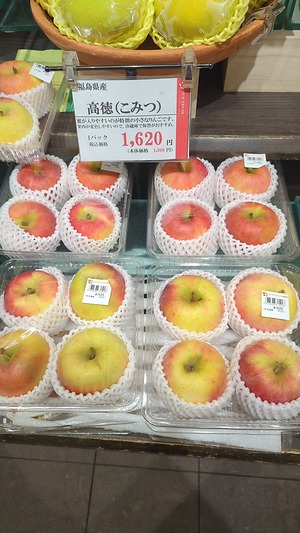


Komitsu Apples
Estimated Inventory, lb : 0
Description/Taste
Komitsu apples are smaller than other commercial Japanese apples, averaging 200 to 300 grams in weight, and have a round, oblate, flattened shape with a prominent concave base and calyx. The fruit’s shoulders are flat and somewhat square, and the entire apple typically fits into the palm of a hand. The skin is semi-thin, smooth, taut, and glossy, often enveloped in a sticky coating. This waxy, tacky layer is created from the natural production of substances in the fruits during ripening to protect the skin from losing moisture. The sticky coating is edible or can be easily wiped from the surface with a cloth. Komitsu apples ripen from green to golden yellow and showcase large patches of crimson, bright red, and dark red blush and broken, irregular striping. The amount of striping will vary per fruit, depending on sun exposure during cultivation, and the apples are known for having a bright appearance. The surface also exhibits prominent lenticels. Underneath the skin, the pale yellow to ivory flesh is hard, dense, textured, aqueous, and firm, with a crisp, crunchy, and chewy consistency. The flesh is also known for its high juice content, sometimes pooling into air pockets around the core, creating a marbled appearance. The central fibrous core contains tiny black-brown inedible seeds that should be discarded before consumption. When ripe, Komitsu apples release a strong, fruity aroma and should feel heavy for their size, indicating juice content. The fruits are high in sugar, ranging from 14 to 16 degrees Brix, and are balanced with bold acidity, developing a refreshingly sweet, mild, and tangy taste.
Seasons/Availability
Komitsu apples are harvested in the late fall through early winter in Japan and are exclusively grown in the Aomori Prefecture. Once picked, the apples can be kept in cold storage until the late spring.
Current Facts
Komitsu apples, botanically classified as Malus domestica, are a rare Japanese variety belonging to the Rosaceae family. The late-season apples were naturally bred in the Aomori Prefecture in the 20th century and were selected as an exclusive commercial variety for their honey-filled flesh. The name Komitsu translates from Japanese to mean “small honey,” as “ko” is “small” and “mitsu” means “honey.” Komitsu apples are the brand name for the highest quality Koutoku apples. The apple brand was developed in the early 21st century as a tool to increase the fruit’s popularity, and Komitsu was marketed using its distinct characteristics as positive selling points. Historically, the variety was notably smaller than other Japanese cultivars and was ignored by commercial growers as they were deemed unfit for production. Over time, through several marketing efforts, the small apples transitioned from being unknown to widely favored, and consumers began appreciating Komatsu’s small size as an easy-to-eat, individually portioned fruit. Komitsu apples were also promoted for their honey-filled flesh, pockets of liquid that give the flesh a marbled appearance. Honey has become a desired trait among Japanese consumers, and Komitsu apples can contain up to 80% honey, a percentage much higher than other available commercial apples. Komitsu apple slices have a distinct, translucent appearance when thinly sliced and held to light, and since its revival, the Komitsu apple brand has become established as a premium specialty apple only sold in limited quantities in Japan.
Nutritional Value
Komitsu apples may be a source of fiber to regulate the digestive tract, potassium to balance fluid levels within the body, vitamin C to strengthen the immune system, and calcium to build strong bones and teeth. The variety may also provide phosphorus to repair tissues, vitamin E to reduce inflammation, vitamin A to maintain healthy organ functioning, iron to develop the protein hemoglobin for oxygen transport through the bloodstream, and other nutrients, including magnesium, manganese, folate, zinc, and copper. The honey-described liquid in the flesh is comprised of sorbitol and water. Sorbitol is a type of carbohydrate and natural sugar alcohol that dissolves in the flesh and fills air pockets, turning an amber-to-golden hue, which creates the illusion of honey or nectar. This liquid contains ethyl esters, aromatic compounds that emit a sweet, floral, and fruity aroma reminiscent of pineapple. This scent is combined with the sugar-filled liquid in the flesh to evoke the sensation of eating honey, a trait highly revered in Komitsu apples.
Applications
Komitsu apples have a sweet and tangy taste suited for fresh preparations. The variety is traditionally consumed out of hand and is favored for its dense, crisp, and juicy nature. Enjoying Komitsu apples at room temperature is recommended to appreciate their fragrance, and the fruits are traditionally sliced into horizontal rings to showcase their marbled flesh. It is important to note that the flesh surrounding the honey-like liquid will have the sweetest flavor. Komitsu apples can also be cut into pieces, served on cheese plates and appetizer platters, or tossed into salads. The marbled slices can be topped over toast, layered into parfaits, or served as an edible garnish over desserts and ice cream. In addition to fresh preparations, Komitsu apples can be juiced for beverages, added to syrups, or simmered into jams and jellies, but this rare apple is typically eaten raw as a delicacy. Komitsu apples pair well with nuts such as almonds, walnuts, and pecans, maple syrup, honey, vanilla, brown sugar, spices including ginger, cardamom, nutmeg, and cinnamon, and other fruits such as strawberries, peaches, nectarines, and grapes. Whole, unwashed Komitsu apples will keep for 1 to 10 days when stored in a cool, dry, and dark location, such as a cellar or the refrigerator. It is recommended to wrap the fruits in newspaper and store them in a plastic bag. Komitsu apples will lose their honey-like juice in extended storage as the liquid is reabsorbed into the flesh and moisture evaporates from the skin. It is recommended to immediately enjoy the fruits after purchase for the best quality and flavor. Komitsu apples are harvested once ripe, so they will be ready to eat once found in commercial markets.
Ethnic/Cultural Info
The creation of the apple brand Komitsu is a story of revival in Japan. Komitsu apples are the highest quality fruits selected each season of the Japanese apple variety known as Koutoku. When Koutoku apples were first released in the late 20th century, the apples were smaller than other commercial varieties, and growers traditionally left the leaves on the apple trees, leading to irregular skin colorings due to uneven sunlight exposure. This varied aesthetic historically prevented the cultivar from increasing in production and being overlooked by commercial growers. The Ishikawa Agricultural Cooperative in the Aomori Prefecture, the home Prefecture of the variety, decided to establish a new premium brand of Koutoku apples to increase awareness and demand. The Komitsu apple brand was born, and a Komitsu Association was formed within the cooperative to develop marketing campaigns surrounding the brand. Only Koutoku apples with a Brix content of 16 degrees, a sugar measurement in the flesh, are harvested and sold under the Komitsu brand. The apples are left on the tree until ripe, and once measured at 16 degrees, they are picked, allowing their sugar content to level out around 14 degrees Brix in storage. The Komitsu Association spent over seventeen years building effective strategies and sales channels for the apples, and the association also heavily regulates the release of the apples to ensure a level of quality is being maintained for the brand. One of the most unique elements of Komitsu apples is their high honey content. During maturation, extended periods of sunlight and heat on the apples cause a concentrated, sweet, sap-like liquid to leak from the intercellular walls, filling the air pockets within the flesh. The sweet liquid has high concentrations of natural sugar alcohol known as sorbitol. Despite its sugar descriptor, the honey-like liquid has been studied by the National Agriculture and Food Research Organization in collaboration with the Apple Research Institute of the Aomori Prefectural Industrial Technology Center. In their research, it was discovered that the honey-like liquid has the same sugar content as the rest of the flesh, but what made it seem like it was sweeter was the presence of aromatic ethyl ester compounds. These compounds emit a sweet and fruity aroma, contributing to the Komitsu apple’s memorable taste.
Geography/History
Komitsu apples are native to Japan and were developed in the Aomori Prefecture in the 20th century. The variety was initially created by Jinya Kimura, former director of the Aomori Prefecture Apple Experiment Station, now known as the Aomori Apple Research Institute, from 1952 to 1970. After his retirement from the institute, Mr. Kimura hybridized apple seedlings in his private orchard in Kashiwagi Town within the Minamitsugaru District in the 1970s. It is said that Mr. Kimura had over 73 trees and dedicated his time to apple breeding before passing away in 1982. After his passing, one of the seedlings was selected from Mr. Kimura’s orchard and was examined by a team of other breeders and scientists as a possible new commercial variety. An application for variety registration was filed in 1984, and in 1985, the variety was officially recognized as a new commercial apple under the name Koutoku. The new variety was thought to have been derived from Toko apples, but after DNA analysis was conducted, it was determined that the fruits were derived from a cross between Rom 16 and Fuji apples. After its official release, Koutoku apples struggled as they were challenging to cultivate and had characteristics differing from popular cultivars at the time. At one point in its history, Koutoku apples were on the verge of extinction. Koutoku apples were saved by members of the Aomori Prefecture Tsugaru Ishikawa Agricultural Cooperative through increased marketing and promotion of the variety. Cooperative members pushed the apple’s unique honey features and developed a marketing campaign around the rarity of the variety. They also created Komitsu, a premium apple brand that sells the highest quality Koutoku apples. Today, Komitsu apples are still grown on a small scale and are challenging to find in markets, but the apples are increasing in demand as a seasonal delicacy. Komitsu apples are primarily grown in the Aomori Prefecture and are also cultivated in smaller quantities in the Yamagata, Ibaraki, and Fukushima Prefectures. When in season, the apples are primarily sold through high-end retailers and distributors.










